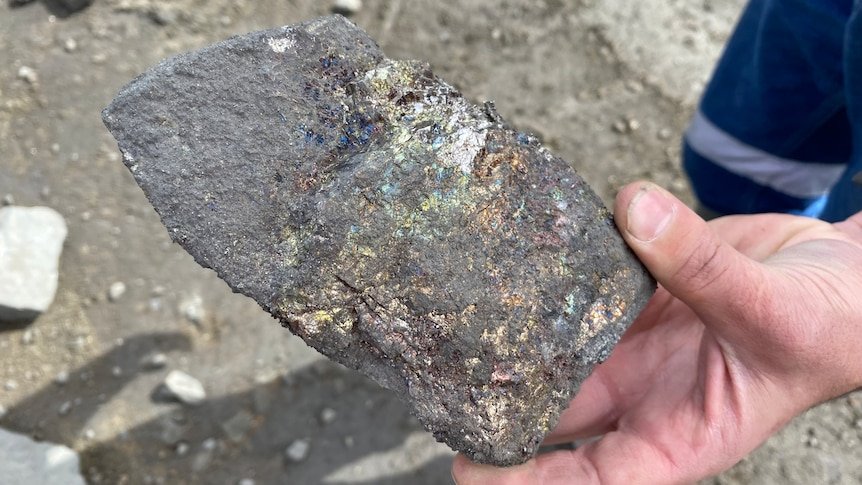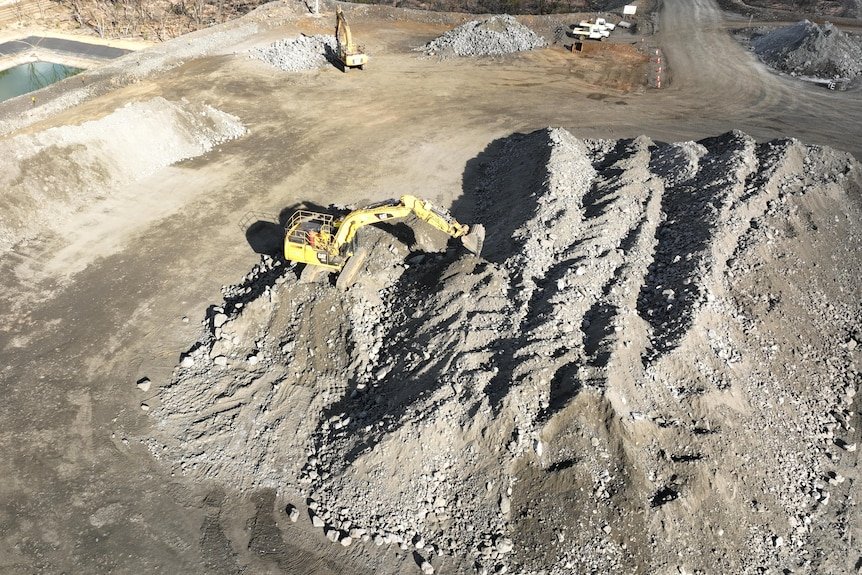Why miners are racing to produce one of the world’s most in-demand metals
Australian nickel is in high demand. (Rachel Pupazzoni, ABC News.)
Mining companies in Australia are racing to find the next big reserve of one of the world's most in-demand metals.
Nickel is a critical metal in batteries, and as the world keeps moving toward renewables, more batteries are needed to store energy.
In fact, there's a strong case that much more of it is needed than lithium — a commodity many people know of, because it is in the name of lithium batteries.
But there are a variety of batteries made with different metal compositions and, as Elon Musk puts it, batteries need a sprinkle of lithium compared to nickel.
"The lithium is actually 2 per cent of the cell mass," he said at a presentation in 2016.
"It's a very small amount of the cell mass and a fairly small amount of the cost, but it sounds like it's big because it's called [a] lithium-ion [battery] , but our batteries should be called nickel-graphite, because it's mostly nickel-graphite."
About 50 kilograms of nickel goes into each Tesla battery.
A report by the CSIRO shows about five times as much nickel (48,006 kilotonnes) will be needed to meet global demand by 2050 as lithium (8,990 kilotonnes).
The problem the world now faces is finding enough nickel to make all the batteries needed.
The search is on to find more nickel to meet the growing demand for the critical battery metal.(Supplied: Panoramic Resources)
Nickel lost its shine
Australia was once a world-leading producer of the shiny metal.
Such was its demand, nickel fetched as much as $US52,000 ($73,700) per tonne in 2007.
But just as prices were rising, the global financial crisis hit, sending the commodity spiralling down, to as low as about $US9,000 ($12,700) in October 2008.
Dozens of mines closed, including a brand new nickel mine opened by BHP in Ravensthorpe, in the south of Western Australia. It went under in January 2009, having operated for less than a year.
For years, BHP tried to sell its Nickel West business, but by the mid-2010s it decided to hold onto it and invest in the commodity.
Now, BHP is ramping up its nickel production and is on the hunt for more mines.
The search for nickel
Last week, BHP announced an unsolicited offer to buy nickel and copper miner Oz Minerals for $8.3 billion.
Oz Minerals advised shareholders to reject the bid, saying it was "highly opportunistic" and significantly undervalued the company.
BHP has deals to sell its nickel to three major car makers.
"I think there's a fantastic opportunity with the Tesla, the Ford and the Toyota agreements," BHP Nickel West asset president Jessica Farrell told The Business.
"I think it is a sign of a direct relationship with the miner and the car manufacturers and we're very well placed to provide sustainable nickel to the battery sector."
BHP Nickel West's Jessica Farrell wants to increase its nickel reserves so it can fulfil orders from car manufacturers.(ABC News: John Gunn)
While Ms Farrell said BHP had enough nickel to fulfil those deals, it clearly wants more.
"We have the second-largest nickel sulphide deposit globally in the Agnew-Wiluna belt, which is an incredible deposit," she said.
The Agnew-Wiluna belt is a geological strip of land rich in nickel and other commodities that stretches south, roughly through the middle of Western Australia, where other miners also operate.
"We're certainly not short of customers … in terms of what we see in the demand trajectory," she said.
"We're actively exploring globally, and we've significantly increased our own exploration spend within the portfolio of the land tenure that we have."
BHP is set to spend billions of dollars because it sees demand only rising.
"If we look out to 2030, we see a 60 per cent increase in electric vehicles and then out to 2040 we see that going up another 30 per cent, to 90 per cent," she said.
"So, we see an incredibly good trajectory for demand — and that's globally.
"We'll also see that transition locally, I think, a lot faster than we expect."
More mines needed
BHP isn't the only company expanding its nickel operations.
In June, the ink dried on a deal that saw Australian company IGO buy nickel miner Western Areas for $1.3 billion.
The deal adds another two nickel mines to IGO's portfolio: the already-in-production Forrestania mine as well as Cosmos, where mining is due to start by the end of this year.
IGO produced 24,000 tonnes of nickel metal concentrate from its Nova mine last financial year.(ABC News: Jon Kerr)
It also extends the life of its existing Nova site, where it has been mining nickel since 2017.
"Since then, it's just been delivering fantastically consistent production levels for IGO and fantastic financial returns," IGO managing director Peter Bradford told The Business.
Peter Bradford runs one of the major nickel and lithium miners in Australia.(ABC News: John Gunn)
But it is not the first time IGO has tried to add to its nickel portfolio.
In 2019 it attempted to buy Panoramic Resources, a company with a nickel mine called Savannah in the Kimberley region, in the far north-east of Western Australia.
While Mr Bradford is remaining tight-lipped on whether it will make another takeover attempt, its purchase of Western Areas does give it a 21.5 per cent stake in Panoramic.
It also has about 10,000 square kilometres of land around Panoramic's mine that it is currently searching for nickel.
"What we're exploring for is a repetition of Nova or a repetition of the Savannah mine that Panoramic have," he said.
"What we may or may not do with the 21.5 per cent interest in Panoramic will depend on the success around that exploration of assets in the Kimberley."
Panoramic's managing director, Victor Rajasooriar, told The Business he was focused on expanding operations, regardless of IGO.
"At the end of the day, they have 21 per cent of the company, they are a supportive shareholder and we can coexist," he said.
Panoramic Resources managing director Victor Rajasooriar says he's focused on delivering for shareholders, not another potential takeover by IGO.(ABC News: John Gunn)
"Our main purposes is to get this project up and running properly, ramp up to nameplate capacity, work safely and increase shareholder wealth, and they will benefit from that.
"That's what we can control, and that's what we will do."
Price play
The vast majority of nickel mined in the world doesn't go into batteries – it's used to make stainless steel.
"But certainly over time, expectations are that [electric vehicles] will become a much larger piece of the demand pie for nickel," resources division director at Macquarie Hayden Bairstow told The Business.
"It is about 15 per cent now of the global nickel demand market, if you like, for electric vehicles.
"That's certainly grown from basically nothing a few years ago, and the expectations are that it will move into the 20s and 30 per cent of the total, and beyond that over time, as the EV market gets larger and larger."
As that demand grows, so too does the price, which swung wildly at the start of 2022.
At the end of 2021, nickel was selling for roughly $US20,000 – a far cry from the pre-GFC peak, but more than double its 2008 low.
It had been increasing fairly steadily for the last few years, along with battery demand.
But as Russia invaded Ukraine the price soared, briefly to as high as $US100,000 a tonne before the London Metals Exchange halted trading and cancelled the day's transactions.
Russia is one of the biggest global suppliers of nickel and there were fears of a massive shortage, just as demand was growing.
The nickel price has once again stabilised to about $US24,000 a tonne.
Space to play or pause, M to mute, left and right arrows to seek, up and down arrows for volume.
The next iron ore of mining
With prices now back rising in a more normal range and car makers pleading with miners to find more nickel, the sector is trying to expand as fast as it can.
"But nickel is very hard to find," explained David Southam, the outgoing managing director of nickel miner Mincor.
"It's a race to secure those critical minerals and the Western world has probably fallen a little bit behind [and] is now playing catch up."
David Southam stepped down as Mincor Resources managing director this month.(Supplied: Mincor Resources)
David Southam stepped down as Mincor Resources managing director this month.(Supplied: Mincor Resources)
While Mr Southam may be leaving the company (Mincor's new managing director, Gabrielle Iwanow, steps into the role later this year), he only sees growth for the sector.
"It's that fundamental shift in the supply-demand, with the demand for electric vehicle batteries, for battery storage, where nickel content gives you the longevity in the battery that means you can travel further, that has fundamentally shifted," he explained.
"It's almost like iron ore, with the Chinese infrastructure boom, that took off, and nickel is very similar."
"The price has gone up, which has enabled projects to get off the ground," he told The Business.
"With this fundamental shift in the market, if you can produce clean, green nickel, because it will be traced right through to the vehicle, you've probably got a pretty good future ahead of you."






